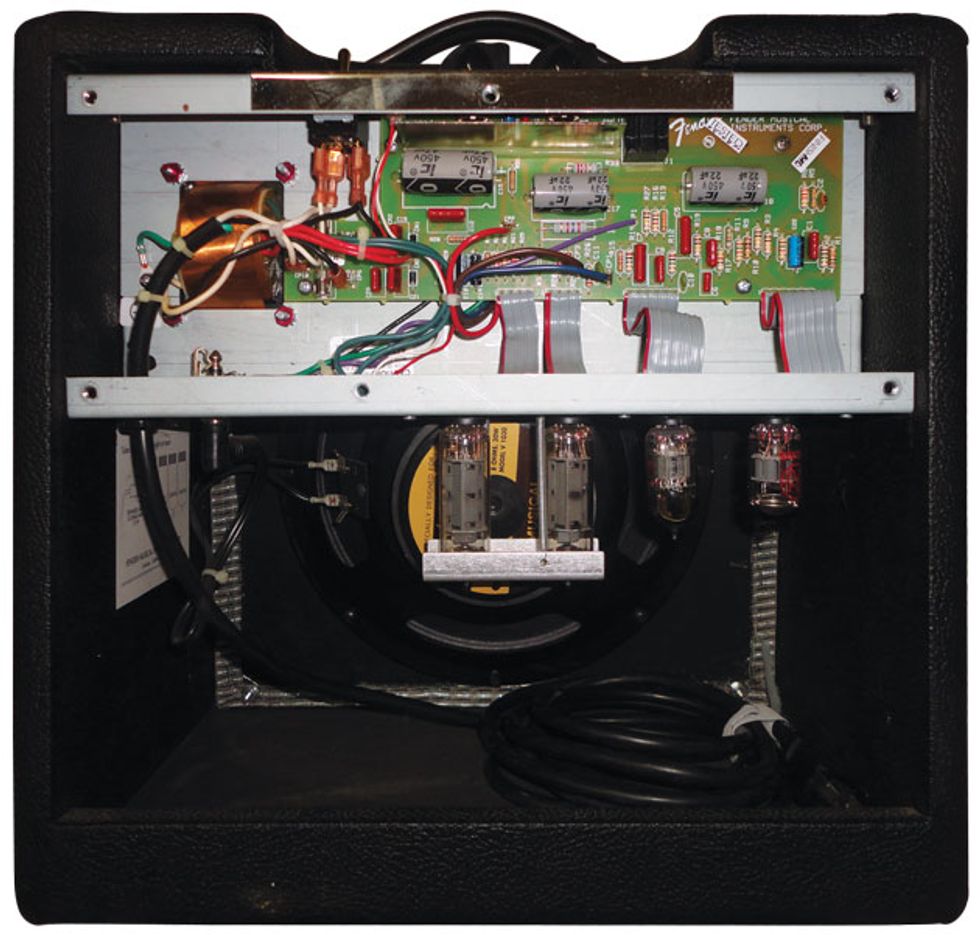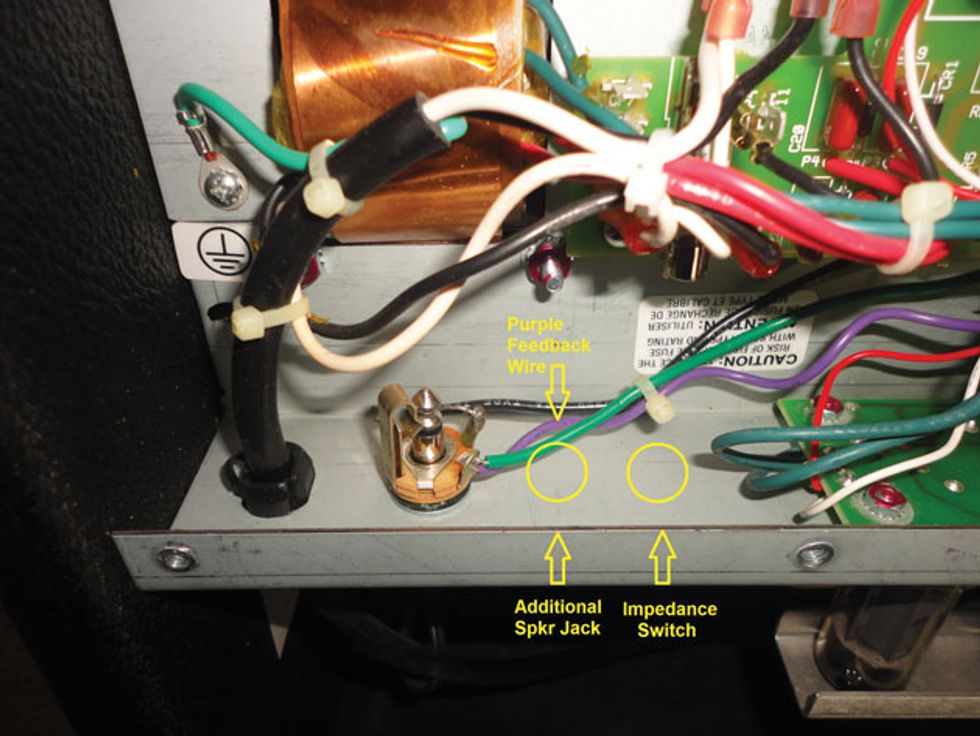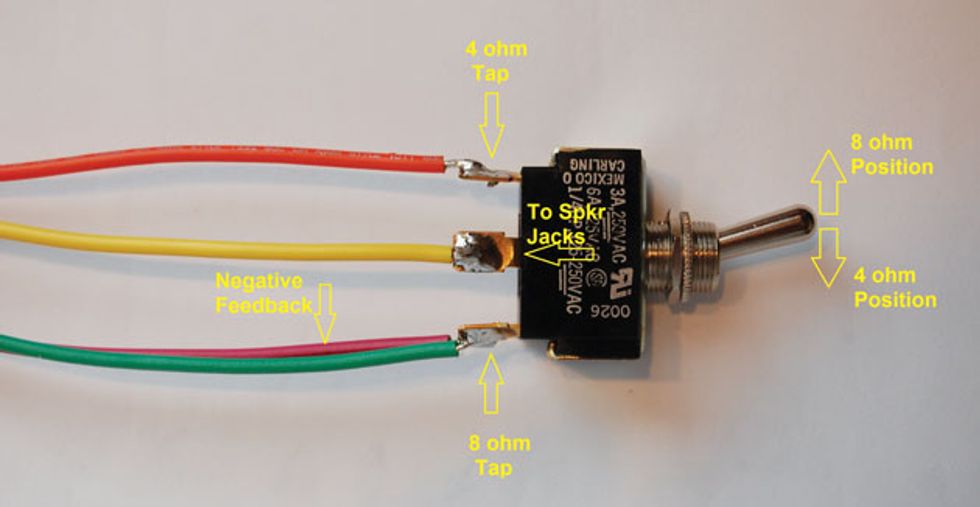Hi Jeff,
Thanks for looking into my question. I enjoy your articles.
I love my little Pro Juniors. Sometimes I run them in stereo. I would like to try and keep my Pro Junior with its little 10" speaker and add a 12" speaker cabinet that I currently own to it. I will be buying a better 12" speaker for this cabinet. It seems to me that this could have an overall wonderful sound and, I hope, add a little volume. I’m looking for max headroom as I get all of the distortion I need out of my pedals.
What do you think of this? Have you ever heard about anyone doing this before? I know the impedance will be the big issue. Could a resistive network be added some way to get closer to an overall 8-ohm load? Would I have to add a switch in case I ever just want to play the Pro Junior in its original configuration? Will I ever stop asking questions?
Thanks for your time,
Tom Brown
Hi Tom,
Thanks for enjoying the column and submitting your question. The Pro Junior amp is pretty ubiquitous and has been many players’ small venue workhorse for quite some time. Heck, a pair have even been seen stacked atop a Marshall cabinet behind some player you may have heard of, who goes by the name of Jeff Beck? Anyway, the short answer to your question is: No! You can’t just add another speaker to the amp without causing a 50 percent impedance mismatch.
Now, sometimes a 50 percent mismatch is not such a terrible thing—especially if the load on the transformer decreases (the impedance number gets bigger). Even the opposite didn’t seem to be catastrophic back in the day of overbuilt output transformers in Fender amps. For years players ran extension cabinets connected to the extension speaker jack on many a Fender combo amp. Seems like the right thing to do, yes? Again, no! The output impedance of the transformers in those amps, as yours, was optimized for the speaker load of the combos. Anything additional was a theoretical overload. In the early years of Fender amps, it seems the output transformers were over-engineered and underwhelmed by overload. Nowadays I don’t feel this is the case. Anyway, so much for a trip down nostalgia lane. Here’s my suggestion for your amp.
In order to attain the versatility you’re trying to have with your combo, you’ll need to have the output transformer replaced along with a couple of other changes. This sounds like a large undertaking, but could actually be for the better, above and beyond giving you increased capability. Many aftermarket transformers are built with better design and materials than what is used in production amps trying to meet a price point. Better iron equals better sound.
To accomplish what you’re looking to do, you will need to install an aftermarket transformer that has multiple output impedance taps. It will need to have a minimum of a 4- and an 8-ohm tap, as the internal speaker in the Pro Junior is 8 ohms. Adding any additional speaker load will require switching to a 4-ohm tap, provided your external speaker is a minimum of 8 ohms. Use of a 4-ohm extension speaker puts us in unhealthy load territory, although if you chose to run the external speaker only, you’d be fine on the 4-ohm setting. Okay, so much for the explanation: Let’s see what this takes to execute.
There’s plenty of room in the Pro Junior’s spacious chassis to make all the required modifications.
There are quite a few manufacturers and resellers that make transformers to build and upgrade with. You’ll need to source a transformer with a primary impedance suitable for a pair of EL84’s in a push-pull configuration. This is typically 8K ohms (8,000 ohms) center-tapped. You’ll also need secondary taps of 4 and 8 ohms. Some also come with a 16-ohm tap. This is not necessary, but could be handy in certain situations. If you search the web for Pro Junior/Blues Junior replacement output transformers, you’ll certainly find a few with the additional 4-ohm tap, but you don’t have to stop there. You might also want to search out aftermarket transformers for a Deluxe. Where a standard Pro Junior transformer is theoretically designed for a 15-watt amp, a transformer for a Deluxe is designed for a 20-watt amp, but it still has the same primary impedance of 8K ohms. While installing this will in no way increase the power of your amp, it may give you a fuller sound and tighter low end, because sometimes more iron equals better sound, too! Additional options to consider: Do you want a transformer designed for a blackface or silverface Deluxe, or might you want to be a bit more old-school grungy and go with a transformer designed to tweed Deluxe specs? One more option might be to grab a transformer designed for an 18-watt British amp utilizing two EL84s.
Fig. 1 — You’ll need to drill holes in the amp’s chassis to install a jack for an additional speaker and an impedance switch.
Installing one of these transformers may require an additional hole to be drilled in the chassis for mounting, as the hole spacing may not be the same. There’s certainly plenty of real estate on the Pro Junior’s chassis, so this won’t be a problem. In addition to the mounting hole for the transformer, you’ll need to drill two more additional holes in the chassis: one adjacent to the stock speaker jack to mount the additional speaker jack and one more in that general area for a switch (Fig 1). Wire the two jacks in parallel and install a SPDT (single pole, double throw) switch to connect the 8- and 4-ohm transformer taps (Fig 2). Be sure to connect the negative feedback wire to the 8-ohm tap. Wire the common (center) connection of the switch to the output jacks and, voila, the Pro of your dreams!
Fig 2. — A single pole, double throw toggle switch will allow you to change the impedance level on your transformer.
Set the switch to 8 ohms for internal-speaker-only operation or set it to 4 ohms for an additional cabinet. You could also set it to 4 ohms while using just the internal speaker, as this would reduce the clean output power by approximately 40 percent, should you need the amp just a bit quieter. Should you source a transformer with a 16-ohm tap, you could always install a 3-position rotary switch and add 16-ohm capabilities, too, just in case you want to disconnect the internal speaker and plug the full power of the amp into a big ol’ 4x12.
There you go. A truly professional Pro Junior.











![Rig Rundown: Russian Circles’ Mike Sullivan [2025]](https://www.premierguitar.com/media-library/youtube.jpg?id=62303631&width=1245&height=700&quality=70&coordinates=0%2C0%2C0%2C0)


























